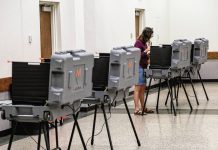The number of white students enrolled in Bartholomew Consolidated School Corp. is declining, a sign that Columbus — like the rest of Bartholomew County and other surrounding areas — is seeing a shift in the population.
Total enrollment of white students in BCSC schools has dropped by about 8.4 percent in the past 10 years, according to the Indiana Department of Education. But when all county school-age students are taken into consideration, the reduction in white students becomes 2.7 percent.
John Quick, superintendent of BCSC schools, attributes that drop to the overall shift in the demographics of the Columbus/Bartholomew County area, which is predominantly white.
The population is gradually getting older, Quick said, and adults within the age to have children are choosing to have fewer of them. The number of births in Bartholomew County dropped by about 2.7 percent from 2005 to 2014, with a 21.8 percent drop in the births of white children in the same time frame, according to the Indiana Department of Health.
As a result, there are currently fewer white children to enroll in local schools.
On average, an estimated 18,583 Bartholomew County residents were enrolled in some level of school — from preschool to higher education — between 2005 and 2009, with about 16,902 white students in the county at that time, according to the American Community Survey of the U.S. Census Bureau.
From 2010 to 2014, the average number of residents enrolled in school rose to 19,622, but the number of white students in school had dropped to 16,454, according to the report.
The shift in the age of the Bartholomew County population — a contributing factor in the enrollment trends — has been occurring the past decade, according to the U.S. Census Bureau.
From 2005 to 2014, the portion of the Bartholomew County population that is 65 or older increased to about 14.6 percent of the total population.
Minority growth
But despite the downward trend in the number of white students, BCSC’s enrollment has seen a steady increase of about one-half to 1 percent each year for the past six years.That increase comes from the influx of minority students, particularly Hispanics and Asians, who move to the district when their parents take jobs — especially in the local manufacturing sector, Quick said.Companies such as Cummins Inc. and NTN Driveshaft often recruit workers from Asian- or Spanish-speaking countries, and those workers often move to Columbus with their families.
“We’re bucking the trend” of enrollment declines, Quick said.
Aside from the high-growth suburban doughnut counties surrounding Indianapolis, many southern Indiana school districts are losing enrollment, the superintendent said.
In nearby Flat Rock-Hawcreek School Corp. in Hope, which has a 95 percent white student population, the number of white students has fallen by about 27.3 percent since 2006, according to the education department.
The district’s overall enrollment has fluctuated in that time frame, but has been on a mostly downward slope in the past six years.
Unlike Columbus, Hope is a predominantly rural area that does not have a strong industrial sector. As a result, fewer minority students move into the school district and, therefore, cannot balance out the declining white population.
“If it weren’t for in-migration and companies that recruit (English language learners),” Quick said, “we would have declining enrollment like other school districts.”
White students now make up about 73.6 percent of the BCSC student population, a 13.7 percentage point drop over 10 years.
Conversely, the Hispanic student population has grown to 13.6 percent of the total student population — an 8.9 percentage point increase.
Additionally, the number of Asian students — who made up only 2.1 percent of BCSC’s total student body in 2006 — has tripled in a decade’s time. Now representing 5.8 percent of student enrollment, Asian students have become the third largest ethnicity in the district.
Home-buying trends
The aging population demographic data matches what Holly Downey, a local Realtor with Century 21 Breeden, said she is noticing in her clients.The majority of buyers looking for a home in Bartholomew County are families, but there has been an increase in the number of older residents wanting to settle in the county in the past five to six years, Downey said.Many of those older residents are moving to Bartholomew County to be closer to their children and grandchildren who live in the area, Downey said.
Mirroring BCSC minority enrollment trends, Downey said she has noticed a sharp increase — specifically in Columbus — in the number of minority families looking for a local home in the past five to six years.
Sometimes the workers moving into Columbus choose to rent a place to live because they are not sure how long they will stay at the job, said Jan Hexamer-Gardner, president of Century 21 Breeden.
But there are shortages of suitable homes available to rent or buy, Hexamer-Gardner said, which forces some workers to locate their families to an area outside of Columbus and commute to work every day, she said.
The average price local buyers are willing to pay for a home is in the $200,000 to $250,000 range, Hexamer-Gardner said. The shortage is affecting homes in the $200,000 _ $350,000 range.
“They look elsewhere because the supply doesn’t equal the demand,” she said.
Jackson County trends
The situation is different in neighboring Jackson County, where the decline in the number of school-aged children has not been as sharp.Census data shows the Jackson County population also is getting older, but births have declined to a lesser degree than in Bartholomew County — down about 0.3 percent total in 10 years, with white births down about 11.4 percent, according to the health department.The number of white students enrolled in a Jackson County school — including all public school corporations, private schools and college students — rose to an average of 9,394 from 2010-14, a 4 percent gain. The overall county white population, however, fell to an average of 38,684 from 2010-14, down from 39,177 in the previous five-year period.
Specifically in Seymour, the county’s largest city, the number of school-aged residents was virtually unchanged from 2005 to 2014, but the number of residents 65 years old or older grew by about 1 percent.
As a result, the population of white students in Seymour Community School Corp. in Jackson County dropped from 3,482 in 2006 to 3,379 in 2015, according to the state Department of Education.
But like Columbus, Seymour is home to several manufacturing companies, which means minority workers — especially Hispanic workers — are moving into the area.
The number of Hispanic students enrolled in Seymour Community Schools rose from 229 in 2006 to 823 in 2015.
Johnson County trends
Quick said the trend toward falling enrollment is mostly affecting schools south of Johnson County.That south-suburban county has seen increasing enrollment for both white students and the general student population. Census data for Johnson County shows that the number of all county residents enrolled in school rose from an average of 34,567 from 2005 to 2009 to an average of 38,416 from 2010 to 2014.The number of residents 65 and older has increased by less than 1 percent during this time.
The Johnson County birth rate also is on the rise, up about 8.2 percent in the past decade, according to the health department.
As a result, enrollment in Johnson County schools has not suffered the decline in white students experienced Bartholomew County.
In Franklin Community School Corp. just north of Columbus, the white student population has actually increased by about 1.2 percent in the past decade, while the district’s overall enrollment has increased by 7.2 percent, according to the Department of Education.
The county’s proximity to Indianapolis makes it an attractive place to live for people who are still at an age where they are working and raising families, Downey said.
When she works with clients in Johnson County, it’s often a dual-income couple looking for a place to live that is halfway between one spouse’s job in Indianapolis and the other’s job in Columbus or another south-central Indiana city.
Reversal coming?
While the effects of an aging population are largely out of the Columbus district’s control, Quick said there are signs that the pendulum will eventually swing back the other way.The majority of students who graduate from Columbus North, Columbus East or Columbus Signature Academy — New Tech high schools and decide to go on to college choose to stay in Columbus and attend one of the local universities, Quick said.The number of Bartholomew County residents who are enrolled in either an undergraduate or graduate program has risen to an average of 3,687 students from 2010 to 2014, according to census data. As the universities continue to grow, more and more students will enroll there, Quick said.
Many of the students who graduate from those colleges choose to settle in Bartholomew County after college, Quick said, so eventually their children will enroll in the local schools.




